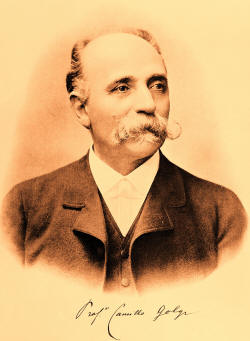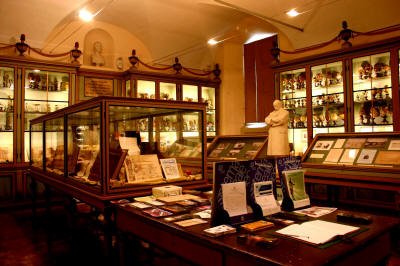Camillo Golgi (1843-1926)
Golgi was born in Corteno, a small mountain village in the Italian province of Brescia. He studied medicine at Pavia University, graduating in 1865 aged just 22. In 1872, Golgi took a post as resident physician at a hospital for the chronically ill, in a small town called Abbiategrasso, near Milan.
He studied medicine at the University of Pavia under Mantegazza, Bizzozero and Oehl. After graduating in 1865 he continued to work in Pavia at the Hospital of St. Matteo. Golgi himself stated that Bizzozero greatly influenced him and his methods of scientific research; at that time most of his investigations were concerned with the nervous system, i.e. insanity, neurology and the lymphatics of the brain. In 1872 he accepted the post of Chief Medical (reference)
 Officer at the Hospital for the Chronically Sick at Abbiategrasso, and it
is believed that in the seclusion of this hospital, in a little kitchen
which he had converted into a laboratory, he first started his
investigations into the nervous system. Golgi returned to the University of
Pavia as Extraordinary Professor of Histology, went to Siena for a short
time, but returned to Pavia and was appointed to the Chair for General
Pathology in 1881, in succession to his teacher Bizzozero. He settled down
in Pavia for good, and married Donna Lina, a niece of Bizzozero.
Officer at the Hospital for the Chronically Sick at Abbiategrasso, and it
is believed that in the seclusion of this hospital, in a little kitchen
which he had converted into a laboratory, he first started his
investigations into the nervous system. Golgi returned to the University of
Pavia as Extraordinary Professor of Histology, went to Siena for a short
time, but returned to Pavia and was appointed to the Chair for General
Pathology in 1881, in succession to his teacher Bizzozero. He settled down
in Pavia for good, and married Donna Lina, a niece of Bizzozero.
Already while working at the Hospital of St. Matteo, Golgi became interested in the investigation of the causes of malaria and he must be credited for having determined the three forms of the parasite and the three types of fever. After prolonged studies he found a way of photographing the most characteristic phases in 1890.
Golgi discovered his method while working by candlelight in one of the hospital’s kitchens, which he had transformed into a laboratory. The method, now known as Golgi staining or Golgi impregnation, involves hardening of tissue in potassium bichromate and ammonia, followed by immersion in a silver nitrate solution. The Golgi stain visualizes a small number of cells in a tissue sample; the cells are stained at random and in their entirety, so that silhouettes of the cell body, axon and dendrites are clearly visible.
However, the work of greatest importance which Golgi carried out was a revolutionary method of staining individual nerve and cell structures, which is referred to as the «black reaction». This method uses a weak solution of silver nitrate and is particularly valuable in tracing the processes and most delicate ramifications of cells. Golgi himself was extremely modest and reticent about his work and it is not known when exactly he made this invention. All through his life, however, he continued to work on these lines, modifying and improving this technique.
In 1873, Golgi published a paper containing descriptions of hippocampal and cerebellar tissue that he had stained using his new technique. In that paper, Golgi reasserts his belief that the nervous system consists of a reticulum: “I was confronted by the concrete fact; this was the existence of the formation which I have called the diffuse nerve network.”

Drawing of the hippocampus by Camillo Golgi
Golgi received the highest honours and awards in recognition of his work. He shared the Nobel Prize for 1906 with Santiago Ramón y Cajal for their work on the structure of the nervous system. The Historical Museum at the University of Pavia dedicated a hall to Golgi, where more than 80 certificates of honorary degrees, diplomas and awards are exhibited.

Golgi married Donna Lina Aletti, previously mentioned. They had no children of their own, but adopted his niece, now Mrs. Carolina Golgi-Papini in Rome. He died at Pavia, where he had lived all his life, on January 21, 1926.

Connect with us
Contact us today